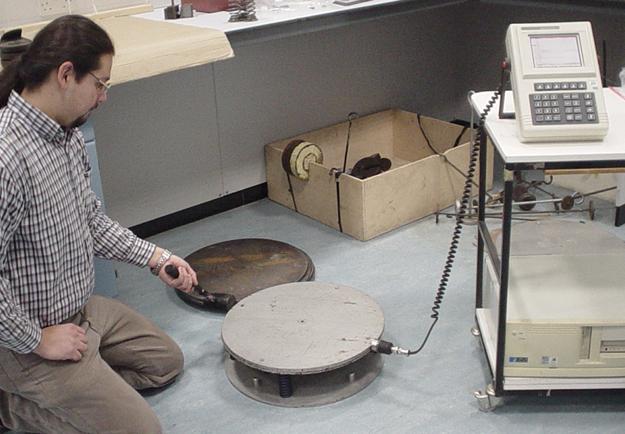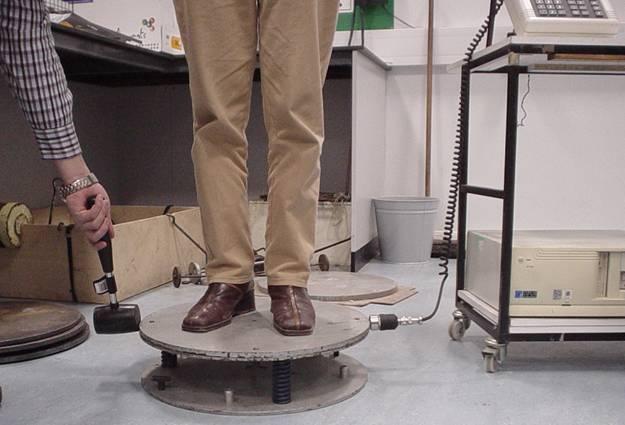The body model of a standing person in the lateral directions
The tests demonstrate that a standing person acts as a mass-spring-damper rather than an inert mass in lateral structural vibration [19.8].


a) A SDOF test rig b) A person standing on the test rig
Fig. 19-8: Test set-up for identifying human body models in lateral structural vibration
Fig. 19-8a shows a single degree-of-freedom rig for both vertical and horizontal directions used for identification tests of human body models in structural vibration. The test rig consists of two circular top plates bolted together, three identical springs supporting the plates and a thick base plate. The test procedure is simple and is the same as that conducted in Section 19.3.1. The free vibration test of the test rig alone was first conducted using a rubber hammer to generate an impact on the rig in the lateral direction. Then a person stood on the test rig and an impact was applied in the lateral direction parallel to the shoulder of the test person as shown in Fig. 19-8b. Fig. 19-9 shows the displacement-time histories and the corresponding spectra of the test rig alone and the human-occupied test rig in the lateral directions. It can be noted from Fig. 19-9 that:
a) Free vibration of the test rig alone b) Response spectrum of the test rig alone
c) Free vibration of a human-rig system d) Response spectrum of the human-rig system
Fig. 19-9: Measurements of the identification tests in lateral directions
- The standing body contributes significant damping to the test rig in the lateral direction (Figs. 19-9a and 19-9c).
- There is one single resonance frequency recorded on the test rig alone (Fig. 19-9b) but two resonance frequencies are observed from the human-structure system in the lateral direction (Fig. 19-9d).
- The single resonance frequency of the test rig alone is between the two resonance frequencies of the human occupied test rig (Relationship 3 in Section 19.2.2)
- Human whole body damping in the lateral directions is large but less than that in the vertical direction as shown by the vibration time history of the human-structure system in the lateral directions which is longer than that in the vertical directions (Fig. 19-7c), although the test structures are different.
The experimental results of the identification tests conducted in the lateral directions clearly indicate that a standing human body acts in a similar manner to a mass-spring-damper rather than an inert mass in lateral structural vibration.
Further identification tests have been conducted on the same test rig with a bouncing person who maintains contact with the structure. It is observed that:
- A bouncing person acts as both loading and a mass-spring-damper on structures in vertical structural vibration.
- The interaction between a bouncing person and the test rig is less significant than that between a standing person and the test rig.
